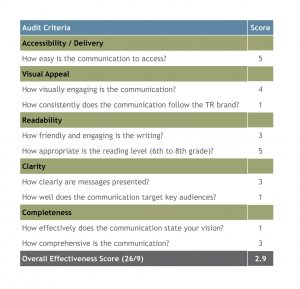Why You Should Audit Your Communication
When clients ask us to design a communication strategy, we often start with an audit of their current materials. Why? Because as Dr. Phil says, “You can’t change what you don’t acknowledge.” A communication audit is simply an objective analysis of your current state that can point you toward an improved future state.
A communication audit starts with an inventory and then a big sort. This is like Marie Kondo pulling all your clothes out of your closet and drawers and dumping them on the guest room bed.
- Ask your team and vendors to send you electronic copies of all your HR and benefits communications. This should include emails, web pages, PDFs, videos, etc.
- Now, sort the communication samples in a way that makes sense for you. For instance, if you have a Total Rewards philosophy with five categories, you might sort the samples into Benefits, Community, Career, Wellbeing and Compensation.
- Sort those categories into campaigns. These might be Annual Enrollment, Incentive Statements, New Hire Orientation, etc.
There will be differences in how your team refers to documents, which can create confusion. For that reason, you’ll want to export an image of each document. It’s easier to know that “postcard #1” is the same item as “AE announcement postcard” when you have a picture of it in your audit report. At this point, you should know each communication element of each campaign. Piece by piece, you’ll run through an objective scoring system that rates:
- Accessibility / Delivery
- Visual Appeal
- Readability
- Clarity
- Completeness
Here is a sample of our scoring system, using a scale of 1 to 5, with 5 being the highest rating. You should rate the communications against industry best practices, and – if you have it – your internal brand guidelines. If you don’t feel informed enough to make these judgements, it may be useful to call in professional help at this point.
You can measure readability using these formulas. Just insert a sample of text, and the tool will give you a grade level report. Generally, 7th or 8th grade is a target reading level that works for lower-level readers as well as for higher-level readers who may just skim content.
Now, you’ll complete a more subjective analysis of each document. There is no reason to make this overly complicated: a simple pros/cons list will do the trick, along with your recommendations for improvement.
For instance, a “pro” might be “The sick leave policy is written and is up-to-date.” A con might be “Reading level is grade 14.” The pros/cons list allows you to flesh out the rating system with the observations that drove the ratings.
Once your ratings are complete, open up Excel. For each of the five categories, determine your average rating. If visual appeal averages out to 1.96, you know you have work to do in this area. We like to provide a summation for each category that speaks to “where you are,” “where you want to be,” and “actionable steps to get you there.”
At the end of your audit process, you should have a comprehensive inventory of your communications. You should also know:
- If each communication element is useful and continues to be required.
- How effectively each deliverable presented its key messages and your overall messaging.
- Specifically, how each deliverable might be improved.
Our clients will generally proceed to the next steps of incorporating the audit results into a total communication strategy. That strategy will move from the deliverable level to a bigger picture view, considering what communication channels may best serve the client’s audiences, and how individual campaigns should be improved as a whole.

